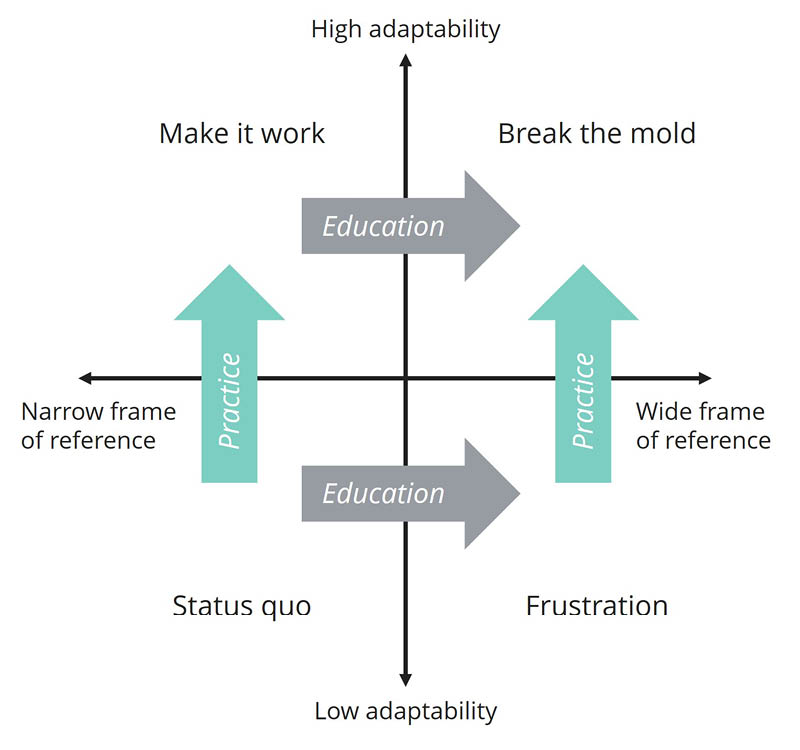

Imagine this: You find yourself in the middle of a complex system, with a mission to improve it. You’re trying to expand your team of changemakers and you have a choice of pulling in outside resources or building talent within. What do you do?
Many managers will look outwards. They look for people with a list of successes on their resumes because if it worked there, they must be great for this organization. Not so fast.
After working in a number of organizations I’ve noticed that people tend to fall into one of four groups when tackling a problem. Recognizing this fact and reacting accordingly can mean the difference between fostering a strong, innovative team and driving brain drain from your organization.
Status quo
People in the left bottom corner of the chart below tend to be very knowledgeable about a narrow area yet not adaptable. They typically feel most comfortable with the status quo. You’ll recognize them by their knowledge of the current processes.
While these team members are helpful subject matter experts and important for daily operations, their low adaptability and narrow frame of reference make them less suited for change activities without training.

Make it work
Organizations often have a handful of people who may have limited knowledge yet have a drive to “make it work” with what they have. That would be the upper left hand corner of the graph.
These are the people who see constraints yet aren’t fazed by them because they accept them as part of the design landscape. You’ll hear people in this quadrant react to an idea as “pie in the sky.” They are extremely practical and adaptable to constraints but their narrow frame of reference means that they may not realize when an alternative is possible.
Frustration
In the bottom right quadrant you have people with a lot of knowledge and exposure to concepts but low adaptability. They often seem like great candidates to lead a change initiative but many either are ineffective because they do not know how to adapt to the organization, or they burn out and move on.
Break the mold
The top right quadrant are the people you need to attract and protect. They are both highly adaptable and have a range of experiences. Unfortunately not all organizations can recognize these people when they have them.
Building a team of changemakers
It’s possible for people to move from one quadrant to another and it’s also possible for an individual to fall in different quadrants depending on the topic.
For people with a narrower frame of reference, training, classes, and introduction to new concepts, frameworks and techniques can be very effective. Be careful however, because expanding the frame of reference of people with low adaptability will just cause more frustration. Frustration = turnover.
If you want to foster more changemakers then you need to encourage both education and adaptability. For less adaptable team members, learning by doing works best. Model the behavior and put them in an environment where they need to be flexible. Provide constraints to push them off of the path of less resistance but also provide some room to fail and learn.
Run experiments and encourage “what if?” questions. Provide a forum or a physical space where team members can take a break from the tactical and think strategically. Run regular retrospectives to help the team reflect on what they’ve learned.
Feel free to recruit from the outside. Fresh perspectives and techniques don’t hurt and might be exactly what your organization needs. Just take some time and think about which quadrant new recruits land in. Regardless of where team members are from, focus on building a team that will “break the mold.”
What techniques do you use to build stronger teams?